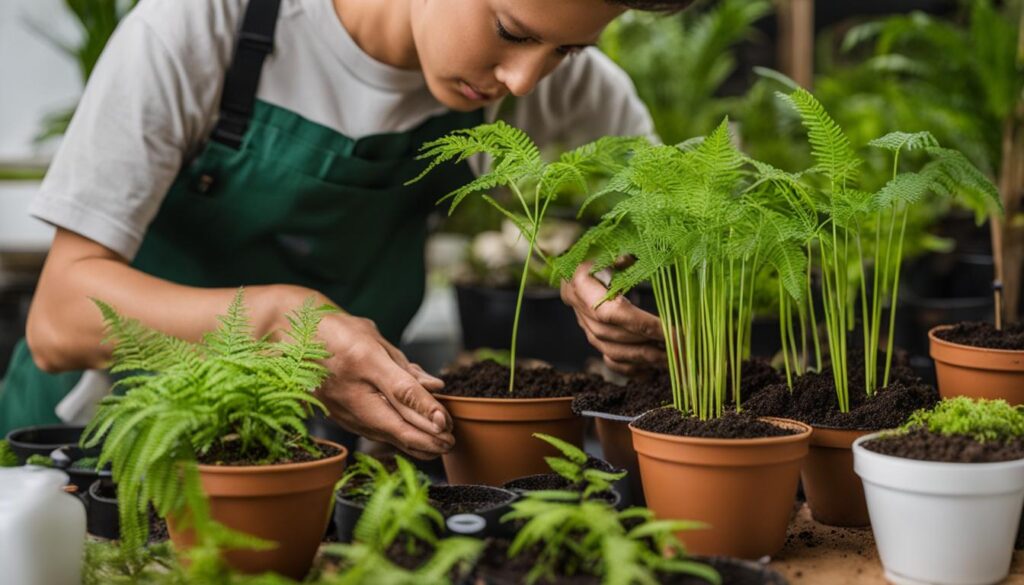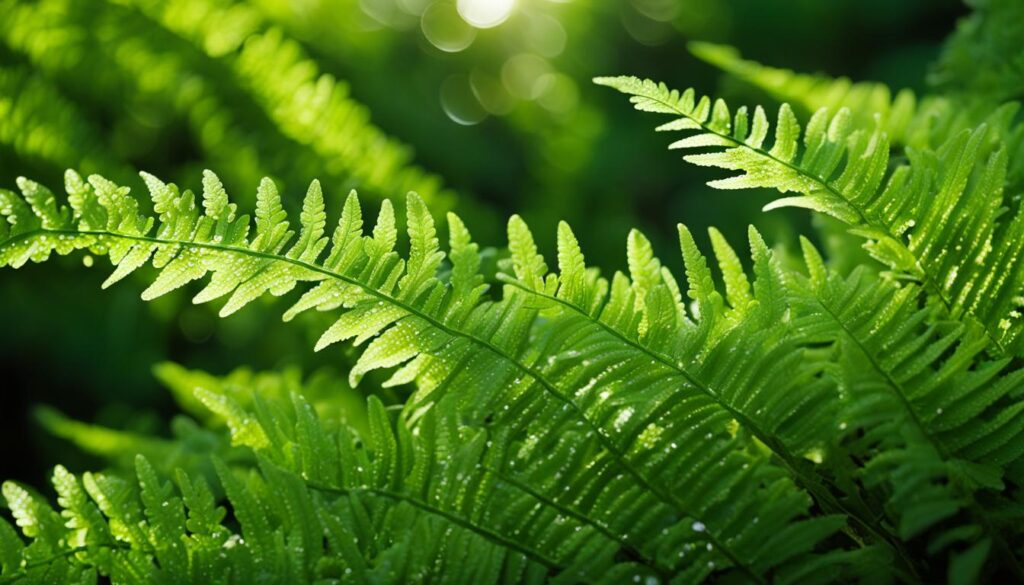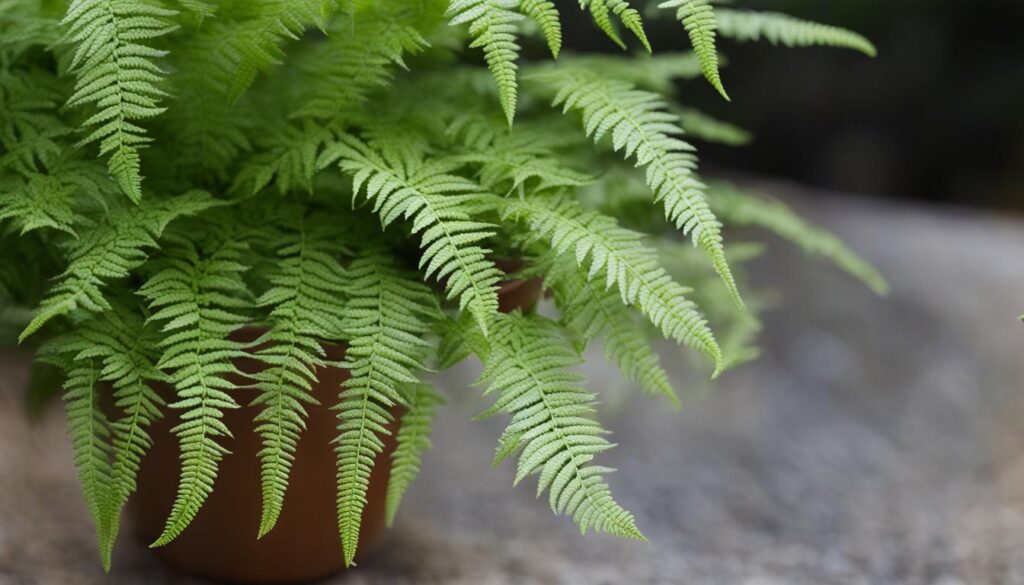Are you looking for a houseplant to add a touch of elegance and greenery to your home? Look no further than the Davallia fejeensis, also known as the Rabbit’s Foot Fern. This beautiful indoor fern is the perfect choice for any plant enthusiast or beginner gardener.
The Rabbit’s Foot Fern is known for its delicately lacy fronds that gracefully cascade from its hanging or potted container. Its creeping scaly rhizomes, covered in fine fur-like hairs, give it the unique appearance of a furry rabbit’s foot. This fern is native to Asia, Africa, and Europe and brings an exotic touch to any indoor space.
Caring for the Rabbit’s Foot Fern is relatively easy, making it an ideal choice for those new to indoor gardening. With the right growing conditions and a little bit of attention, you can enjoy the beauty of this fern in your home for years to come.
Table of Contents
ToggleKey Takeaways:
- The Rabbit’s Foot Fern, or Davallia fejeensis, is a popular indoor fern known for its lacy fronds and furry rhizomes.
- This houseplant is perfect for greenifying your home with its hanging or potted growth habit.
- Providing the right care, including proper watering, light conditions, and soil requirements, is crucial for the Rabbit’s Foot Fern’s health and growth.
- Propagation of this fern can be done through rhizome division or rhizome cuttings.
- The Davallia genus includes other fern varieties, such as Davallia canariensis and Davallia trichomanoides, each with its unique characteristics.
Key Care Tips for Davallia fejeensis (Rabbit’s Foot Fern)
Proper care is essential for the health and vitality of your Davallia fejeensis, also known as the Rabbit’s Foot Fern. By following these key care tips, you can create an ideal environment for your fern to thrive.
- Planting: When planting your Rabbit’s Foot Fern, make sure to expose most of its rhizomes. This allows them to cascade gracefully from the container, creating a visually appealing display.
- Watering: The Rabbit’s Foot Fern requires ample water to stay hydrated. It is recommended to thoroughly water the fern and ensure the soil remains consistently moist. If your environment isn’t naturally humid, consider misting the fronds daily to provide additional moisture.
- Soil: This fern thrives in a loamy and slightly acidic potting mix. Ensure that the soil is well-draining to prevent waterlogged conditions, which can lead to root rot.
- Light: The Rabbit’s Foot Fern prefers dappled light or partial shade. North-facing or east-facing windows are ideal placements to provide the fern with the appropriate amount of light without subjecting it to direct sunlight.
- Humidity: While the Rabbit’s Foot Fern appreciates higher humidity levels, it is less demanding compared to other fern species. However, misting the fronds or using a room humidifier can help create a more favorable environment for your fern.
- Fertilizer: Feed your Rabbit’s Foot Fern with weak liquid fertilizer every two to three weeks during the growing season. This helps supply the necessary nutrients for healthy growth and vibrant fronds.
- Temperature: The Rabbit’s Foot Fern thrives in normal room temperatures around 70 degrees Fahrenheit. Avoid exposing the fern to drastic temperature fluctuations or cold drafts.
- Pruning: Pruning is minimal for this fern species and is usually only necessary to remove dead fronds. Keep an eye out for any fronds that have turned brown or dried out, and gently trim them back to maintain the plant’s aesthetic appeal.
By following these care tips, you can ensure that your Rabbit’s Foot Fern remains healthy and beautiful. Remember to provide adequate watering, suitable lighting conditions, and a nurturing environment to help this captivating fern thrive.
A beautiful Rabbit’s Foot Fern, thriving in its ideal care conditions.
Growing Conditions for Davallia fejeensis (Rabbit’s Foot Fern)
I have found that providing the right growing conditions is essential for the health and vitality of Davallia fejeensis, commonly known as the Rabbit’s Foot Fern. Here are the key factors to consider:
Light:
Rabbit’s Foot Ferns thrive in dappled light or partial shade conditions. While they can tolerate bright indirect light, it is crucial to protect them from direct sunlight. Placing them near east-facing or north-facing windows is ideal.
Soil:
This fern species prefers a loamy, peat-based potting mix with a slightly acidic pH. The well-draining soil allows the roots to breathe and prevents waterlogging, which can be detrimental to the plant’s health.
Watering:
Consistently moist soil is crucial for the Rabbit’s Foot Fern. It is important to water the plant regularly or mist the leaves and rhizomes daily to prevent them from drying out. However, it is equally important to ensure that the soil drains well and that the fern is not sitting in standing water.
Humidity:
Rabbit’s Foot Ferns are less demanding when it comes to high humidity compared to other ferns. However, to maintain optimal health and lush growth, misting the fronds or using a room humidifier is recommended, especially in drier environments.
Temperature:
Maintaining temperatures above 60 degrees Fahrenheit is ideal for the healthy growth of Rabbit’s Foot Ferns. These ferns thrive in typical room temperatures around 70 degrees Fahrenheit. Avoid exposing them to extreme cold or drafts, as it can harm the plant.
Fertilizing:
Providing adequate nutrients is essential for the Rabbit’s Foot Fern. To do this, I recommend fertilizing the plant with a weak liquid fertilizer every two to three weeks during the growing season. This will help promote growth and maintain the fern’s overall health.
By paying attention to these growing conditions, you can ensure that your Davallia fejeensis thrives and adds a touch of natural beauty to your indoor space.
Propagation Methods for Davallia fejeensis (Rabbit’s Foot Fern)
Propagating Davallia fejeensis, or the Rabbit’s Foot Fern, involves two common methods: rhizome division and rhizome cuttings. Both techniques allow you to create new plants from an existing one, expanding your fern collection. Let’s explore each propagation method in detail.
Rhizome Division
Rhizome division is a simple and effective way to propagate Rabbit’s Foot Ferns. This method is best suited for older plants with well-developed rhizomes. Here’s how to do it:
-
Carefully remove the fern from its container and gently separate the rhizomes into two or more sections. Make sure each section has a sufficient number of healthy fronds and viable rhizomes.
-
Plant each section in its own individual pot filled with a well-draining, peat-based potting mix. Ensure that the rhizomes are exposed and the fronds are above the soil surface.
-
Water the newly potted sections thoroughly and place them in a bright, indirect light location. Avoid direct sunlight, as it can damage the fronds.
-
Maintain humidity levels by misting the fronds and keeping the soil slightly moist. Within a few weeks, new fronds should start to emerge, indicating successful propagation.
Rhizome Cuttings
Rhizome cuttings are another method to propagate Rabbit’s Foot Ferns. This technique involves snipping a section of rhizome with attached fronds and rooting it in a suitable potting mix. Follow these steps to propagate your fern using rhizome cuttings:
-
Select a healthy rhizome with 2-3 inches of length and attached fronds. Carefully snip the section, ensuring that each cutting has at least one viable bud.
-
Fill a pot with a peat-based potting mix, then lay the rhizome cutting on the surface, securing it with a wire loop or gently pressing it into the soil.
-
Place the pot in a bright, indirect light location, away from direct sunlight. Maintain humidity levels by misting the fronds and keeping the soil lightly moist.
-
After a few weeks, the rhizome cutting should develop roots and new fronds. At this point, you can treat it as a mature Rabbit’s Foot Fern and continue regular care.

The propagation methods of rhizome division and rhizome cuttings offer fern enthusiasts the opportunity to expand their collection of Rabbit’s Foot Ferns. Each method has its advantages, and you can choose the one that suits your preferences and available plant materials. Proper potting and repotting techniques are necessary to accommodate the unique growth habit of the fern’s rhizomatous roots, ensuring their health and vitality.
Varieties of Davallia Ferns
The Davallia genus offers a selection of fern species that are widely cultivated, each with its unique characteristics. Let’s explore some of the popular varieties:
Davallia solida var. fejeensis
Commonly known as Davallia fejeensis or Rabbit’s Foot Fern, this variety is highly favored among fern enthusiasts. It boasts delicate, lacy fronds that can grow up to 18 inches long, adding an elegant touch to any indoor space.
Davallia canariensis
Also referred to as hare’s foot fern, Davallia canariensis stands out with its larger and coarser rhizomatous roots. Its unique texture and appearance make it a captivating addition to fern collections.
Davallia trichomanoides
Squirrel’s foot fern, or Davallia trichomanoides, displays shorter fronds adorned with smaller exposed rhizomes. This species offers a charming aesthetic with airy and feathery foliage.
These varieties of Davallia ferns exhibit distinct characteristics and have varying water requirements. Select the one that best suits your preferences and care abilities to create a striking display of fern beauty in your home.
| Variety | Common Name | Distinct Features |
|---|---|---|
| Davallia solida var. fejeensis | Rabbit’s Foot Fern | Lacy fronds up to 18 inches long |
| Davallia canariensis | Hare’s Foot Fern | Large and coarse rhizomatous roots |
| Davallia trichomanoides | Squirrel’s Foot Fern | Shorter fronds with smaller exposed rhizomes |

Pruning and Repotting Tips for Rabbit’s Foot Fern
Pruning and repotting are essential aspects of fern care that contribute to the healthy growth and appearance of Rabbit’s Foot Ferns. While pruning helps maintain the plant’s vitality by removing dead fronds, repotting ensures adequate space for root expansion. Here are some useful tips for pruning and repotting your Rabbit’s Foot Fern:
Pruning Tips:
- Regularly check your fern for dead or dying fronds. These fronds can be easily identified as they turn yellow or brown.
- Using clean, sharp pruners or scissors, carefully trim off the dead fronds at the base, ensuring not to damage the healthy foliage.
- Pruning should be done throughout the year whenever dead fronds are present. However, it’s best to avoid excessive pruning, as it can weaken the plant.
Repotting Tips:
Repotting is necessary for Rabbit’s Foot Ferns every two years, preferably during the winter dormant period. Follow these steps for successful repotting:
- Choose a shallow pot with a diameter slightly larger than the current one, ensuring it has drainage holes to prevent waterlogging.
- Prepare a peat-based potting mix that provides excellent drainage and a slightly acidic pH level.
- Gently remove the fern from its current pot, taking care not to damage the roots.
- Inspect the roots for any signs of disease or rot. Trim off any affected areas with clean pruners.
- Position the fern in the new pot, allowing the rhizomatous roots to cascade over the sides. The fern’s natural cascading growth habit can be enhanced by allowing it to slightly overgrow the pot, especially for hanging plants.
- Fill the pot with the prepared potting mix, ensuring it covers the roots and rhizomes but does not bury them excessively.
- Lightly press the potting mix to secure the fern in place.
- Water the newly repotted fern thoroughly, ensuring the water drains out from the bottom.
- During the semi-dormant period from October to March, reduce watering and fertilizing to accommodate the plant’s slower growth.
By following these pruning and repotting tips, you can ensure the long-term health and vitality of your Rabbit’s Foot Fern, allowing it to thrive and adorn your indoor space with its elegant fronds.
Common Issues and Pests for Rabbit’s Foot Fern
While Rabbit’s Foot Ferns are generally easy to care for, they can sometimes face common issues and pests that need attention. It’s important to identify and address these problems promptly to ensure the health and vitality of your fern.
Common Issues
- Damage to Fronds: Rabbit’s Foot Ferns are sensitive to chemicals and air pollutants, such as tobacco smoke and scented candles. Exposure to these substances can lead to damage and discoloration of the fronds.
- Direct Sunlight: Exposing the fern to direct sunlight can cause scorching, resulting in yellow fronds with brown tips. It’s important to provide the fern with dappled or indirect light to avoid this issue.
- Pale Fronds: If the fronds of your Rabbit’s Foot Fern appear pale, it may indicate a need for more fertilizer. Consider adjusting your fertilizing routine to provide the necessary nutrients for healthy growth.
- Limp Fronds: Overwatering can lead to limp fronds in Rabbit’s Foot Ferns. Ensure that the soil is well-drained and allow it to dry out slightly between waterings.
Pests
Rabbit’s Foot Ferns are susceptible to various pests that can infest the plant if not properly controlled. Here are some common pests to watch out for:
| Pest | Description |
|---|---|
| Aphids | Tiny insects that feed on plant sap, causing wilting and discoloration. |
| Mealybugs | Small, white, cottony insects that cluster on the fronds and leave behind a sticky residue. |
| Scale | Hard, shell-like pests that attach themselves to the fronds and sap plant nutrients. |
| Whiteflies | Small, flying insects that gather on the underside of the fronds and can cause yellowing and distortion. |
If you notice any signs of pest infestation, it’s important to take action immediately. Use natural pesticides or consult a local garden center for appropriate treatment options.
To prevent root rot, avoid burying too many rhizomes in the potting mix. It’s best to allow the rhizomes to cover the surface of the soil, ensuring proper air circulation and minimizing the risk of fungal diseases.

Outdoor Cultivation and Differences Among Davallia Species
While the Rabbit’s Foot Fern is typically grown indoors, it can also be cultivated outdoors in warm climates within plant hardiness zones 10-11. However, it requires protection from frost and should be brought indoors when temperatures drop below 60 degrees Fahrenheit.
The Davallia genus encompasses several species commonly grown as houseplants, each with its unique characteristics. The Rabbit’s Foot Fern (Davallia fejeensis) features delicate, lacy fronds and fine, fuzzy rhizomes. On the other hand, Davallia canariensis, also known as hare’s foot fern, showcases coarser fronds and rough, scaly rhizomes. Lastly, Davallia trichomanoides, or squirrel’s foot fern, displays shorter fronds and smaller exposed rhizomes.
Light and Watering Requirements for Rabbit’s Foot Fern
Proper lighting conditions and watering practices are crucial for the health and well-being of Rabbit’s Foot Ferns. Let’s take a closer look at their light requirements and watering needs to ensure optimal care.
Light Requirements
Rabbit’s Foot Ferns prefer bright indirect sunlight, making east-facing or north-facing windows ideal locations for them. It’s important to avoid direct sunlight, as it can cause damage to the fronds. Placing the fern near a window with filtered light or in a well-lit room is recommended to provide the right amount of light for its growth.
Watering Requirements
Watering is a critical aspect of fern care, and Rabbit’s Foot Ferns have specific watering requirements. These ferns thrive with weekly thorough watering, allowing the soil to be lightly moist but not waterlogged. It’s essential to ensure that the potting mix drains well and that the plant is not sitting in standing water, which can lead to root rot.
In addition to regular watering, misting the surface rhizomes daily is beneficial for Rabbit’s Foot Ferns. This helps to prevent the rhizomes from drying out and mimics their natural habitat, which is typically humid.
| Light Requirements | Watering Requirements |
|---|---|
| Bright indirect sunlight | Weekly thorough watering |
| Avoid direct sunlight | Keep soil lightly moist |
| Place near east-facing or north-facing windows | Mist surface rhizomes daily |

With the right balance of light and proper watering practices, Rabbit’s Foot Ferns can thrive and beautify your indoor space. Remember to provide bright indirect light near suitable windows and water the fern at regular intervals while ensuring good drainage. This will help create a favorable environment for your fern’s growth and ensure its health and vitality.
Fertilizing and Special Care for Rabbit’s Foot Fern
Proper fertilizing and special care are crucial for maintaining the health and growth of Rabbit’s Foot Ferns. These beautiful indoor plants require regular feeding and specific attention to their sensitivity to chemicals. By following the right fertilizing techniques and providing extra care, you can ensure that your fern thrives and remains vibrant.
Fertilizing Tips
- Use a light all-purpose liquid fertilizer: Dilute an all-purpose liquid fertilizer in water and apply it to the fern every other month. This provides the necessary nutrients for healthy growth.
- Consider slow-release fertilizer: If your Rabbit’s Foot Fern was potted with a slow-release fertilizer, additional feeding may not be necessary for a few months. Monitor the plant’s growth and adjust the feeding accordingly.
- Promote growth and maintain health: Regular fertilizing helps maintain the fern’s overall health, promotes lush green foliage, and ensures optimal growth.
Special Care Tips
- Be mindful of sensitivity to chemicals: Rabbit’s Foot Ferns are sensitive to chemicals, including leaf shine products and insecticides. Avoid using these products in close proximity to the fern to prevent any harm.
- Gentle showers for cleaning: Use gentle showers to clean and freshen the fronds. This helps remove dust, insects, and improves the overall appearance of the fern.
- Avoid tobacco smoke, scented candles, and air pollution: These substances can be harmful to Rabbit’s Foot Ferns. It’s essential to keep the fern away from tobacco smoke, scented candles, and areas with high air pollution levels.
By following these fertilizing and special care tips, you can ensure that your Rabbit’s Foot Fern remains healthy and vibrant, adding beauty and greenery to your indoor space.
Conclusion
To summarize, growing a Rabbit’s Foot Fern, or Davallia fejeensis, can be a rewarding experience for fern gardening enthusiasts. These indoor ferns have delicate lacy fronds and unique furry rhizomes, adding a touch of nature and elegance to any home.
For successful growth, it is crucial to provide the right care. Proper watering, ensuring the soil remains lightly moist, along with misting the surface rhizomes daily to prevent drying out, is essential. The Rabbit’s Foot Fern prefers bright indirect sunlight and should be protected from direct sunlight to avoid frond damage. Additionally, regular feeding with a diluted all-purpose liquid fertilizer helps maintain the fern’s health and promotes growth.
Understanding the differences among Davallia species, such as Davallia canariensis and Davallia trichomanoides, can enhance your fern gardening experience. By following the care guide and potting methods specific to Rabbit’s Foot Ferns, you can create an ideal environment for these ferns to thrive and flourish.
In conclusion, with proper care and attention, Rabbit’s Foot Ferns can bring the beauty of nature into your home. Whether you are an experienced gardener or a beginner, these ferns offer an opportunity to cultivate a stunning indoor garden and enjoy the lush greenery they provide.
FAQ
What is the Rabbit’s Foot Fern?
The Rabbit’s Foot Fern, scientifically known as Davallia fejeensis, is a perennial houseplant characterized by lacy fronds growing from furry, creeping rhizomes.
What are the care tips for the Rabbit’s Foot Fern?
The Rabbit’s Foot Fern requires ample water, daily misting, indirect light, slightly acidic potting mix, and pruning only for removing dead fronds.
What are the growing conditions for the Rabbit’s Foot Fern?
The Rabbit’s Foot Fern thrives in dappled light or partial shade, slightly acidic potting mix, consistent moisture, temperatures above 60°F, and low to medium humidity.
How can the Rabbit’s Foot Fern be propagated?
The Rabbit’s Foot Fern can be propagated through rhizome division or rhizome cuttings, both best done during the plant’s dormancy period in winter.
What are the different varieties of Davallia ferns?
The Davallia genus includes Davallia fejeensis, Davallia canariensis, and Davallia trichomanoides, each with its unique characteristics and water requirements.
How should Rabbit’s Foot Ferns be pruned and repotted?
Rabbit’s Foot Ferns require minimal pruning, with only dead fronds needing to be removed. Repotting should be done every other year during the plant’s dormancy period, using a shallow, well-draining pot and following a unique potting method.
What are the common issues and pests for the Rabbit’s Foot Fern?
The Rabbit’s Foot Fern may face issues such as frond damage from chemicals and air pollutants, yellowing or pale fronds, and infestations from pests like aphids, mealybugs, scale, and whiteflies.
Can the Rabbit’s Foot Fern be grown outdoors?
The Rabbit’s Foot Fern can be grown outdoors in warmer climates within plant hardiness zones 10-11, as long as it is protected from frost and brought indoors during colder temperatures.
What are the light and watering requirements for the Rabbit’s Foot Fern?
Rabbit’s Foot Ferns prefer bright indirect light and weekly thorough watering to keep the soil lightly moist. The surface rhizomes should be misted daily to prevent drying out.
How should the Rabbit’s Foot Fern be fertilized and cared for?
Rabbit’s Foot Ferns can be fed with a light all-purpose liquid fertilizer every other month, avoiding chemicals and ensuring a clean environment. Gentle showers can be used to clean the fronds.
What are the key takeaways for growing the Rabbit’s Foot Fern?
With the right care, the Rabbit’s Foot Fern can thrive as an indoor fern, bringing beauty and nature into any home. Understanding its specific care requirements, propagation methods, and unique potting techniques will lead to successful fern gardening.











